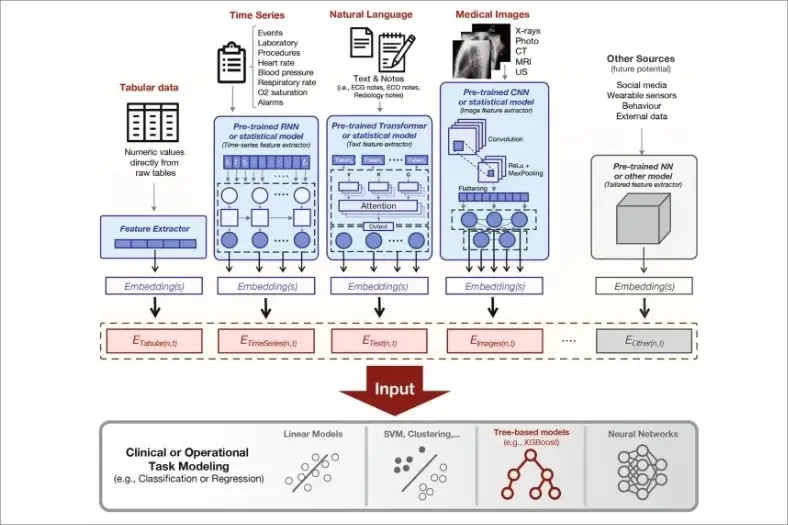Artificial intelligence (AI) and machine learning (ML) systems are poised to become fundamental tools in next-generation clinical practice and healthcare operations is entering a new, exciting phase with the advent of multimodal AI systems. These advanced platforms are capable of integrating and interpreting various types of data simultaneously, heralding a new era of precision medicine and comprehensive healthcare insights. Multimodal architectures for AI/ML systems are attractive because they can emulate the input conditions that clinicians and healthcare administrators currently use to perform predictions and respond to their complex decision-making landscape. A typical clinical practice uses a diverse set of information formats contained within the patient electronic health record (EHR) such as tabular data (e.g., age, demographics, procedures, history, billing codes), image data (e.g., photographs, x-rays, computerized-tomography scans, magnetic resonance imaging, pathology slides), time-series data (e.g., intermittent pulse oximetry, blood chemistry, respiratory analysis, electrocardiograms, ultra-sounds, in-vitro tests, wearable sensors), structured sequence data (e.g., genomics, proteomics, metabolomics) and unstructured sequence data (e.g., notes, forms, written reports, voice recordings, video) among other sources.
Traditional AI systems in healthcare have often operated within the confines of single-mode data analysis, such as processing only imaging data or electronic health records. However, the complexity of human health demands a more nuanced approach. Multimodal AI represents this next step, combining diverse data types – from genomic sequences and clinical images to patient-reported outcomes and environmental factors – to provide a holistic view of patient health.
One of the most significant advantages of multimodal AI is its potential to improve diagnostic precision. By analyzing data from multiple sources, these systems can identify patterns and correlations that might be invisible in unimodal datasets. For instance, combining radiological images with genomic data and clinical histories can lead to earlier and more accurate diagnoses of complex conditions, such as cancer or rare genetic disorders.
Multimodal AI paves the way for truly personalized medicine. It considers the entirety of a patient’s medical profile, including lifestyle and socio-environmental factors, enabling healthcare providers to tailor treatments to the individual’s unique health status. This approach not only enhances the efficacy of treatments but also minimizes the risk of adverse reactions, ensuring that patient care is both effective and safe.
The predictive capabilities of multimodal AI are groundbreaking. By integrating and analyzing longitudinal data, AI can forecast potential health risks and disease progression, offering opportunities for early intervention and preventive care. This proactive approach could transform healthcare from a reactive to a preventive model, significantly improving long-term health outcomes and reducing healthcare costs.
Challenges of multimodal AI in healthcare
While the promise of multimodal models is substantial, their deployment into production systems is not without its challenges. These models tend to be computationally heavy, demanding both significant memory and computational resources. This makes them expensive to run, particularly at scale.
- Availability of data: Multimodal AI in healthcare grapples with limited data availability. Training effective models demands diverse datasets, posing challenges in accessing large, varied datasets, especially for specific medical conditions or rare cases.
- Data integration and quality: Challenges arise in healthcare data integration due to its heterogeneity. Maintaining quality, consistency, and compatibility in multimodal data streams (e.g., electronic health records, wearables, imaging) is crucial. Inconsistencies in data formats and standards impede seamless integration.
- Data privacy and security: Multimodal AI in healthcare prompts concerns about data privacy and security. Merging sensitive patient data demands robust privacy measures, compliance with healthcare regulations , and ensuring secure data transmission, storage, and processing for trust in AI solutions.
- Model complexity and interpretability: Multimodal AI model complexity challenges interpretability, hindering healthcare professionals’ trust. Balancing sophisticated models for intricate relationships with the need for interpretable results remains an ongoing challenge. Achieving this balance is vital for AI acceptance in clinical practice.
The Road Ahead
The future of multimodal AI in healthcare is not just promising; it’s revolutionary. As we continue to advance our technological capabilities and deepen our understanding of complex health data, multimodal AI stands to redefine the landscapes of diagnosis, treatment, and preventive care. However, realizing its full potential will require:
1. Interdisciplinary collaboration
Foster collaboration between data scientists, healthcare professionals, and domain experts. Their collective expertise ensures a holistic understanding of healthcare challenges and facilitates the development of effective multimodal solutions.
2. Ethical considerations and regulatory compliance
Prioritize ethical considerations and adhere to regulatory standards in data handling, ensuring patient privacy and compliance with healthcare regulations. Implement robust security measures to safeguard sensitive healthcare information.
3. Continuous model validation and improvement
Establish a feedback loop for continuous model validation and improvement. Regularly assess and refine multimodal AI models based on real-world outcomes and user feedback to enhance performance and adapt to evolving healthcare needs.
4. User-friendly interface and interpretability
Design user-friendly interfaces that prioritize interpretability. Healthcare professionals should easily comprehend and trust the AI-driven insights, fostering seamless integration into clinical workflows.
5. Scalability and future-proofing
Develop solutions with scalability in mind, allowing for integration into diverse healthcare settings. Future-proofing involves anticipating technological advancements and evolving healthcare requirements to ensure the longevity of multimodal AI solutions.
In conclusion, multimodal AI represents the next frontier in healthcare innovation. It offers a more nuanced, comprehensive, and personalized approach to patient care, embodying the true spirit of innovation in medical science. As we embrace this new era, we must navigate its challenges with foresight, ensuring that we harness the power of AI to enhance health outcomes while upholding the highest standards of ethical practice and data stewardship. The journey of AI in healthcare continues, and its next chapter promises to be as transformative as it is inspiring.



0 Comments